The first part of the Trans-Mongolian adventure revealed us the beauties of the Siberian taiga. If you missed it, you can always catch up with the story by reading my previous blog post.
Get on board with me and let’s explore something new.

The journey continued as we got on Irkutsk – Ulaanbaatar train that early September morning. This train’s staff was Mongolian so we got two Provodnica(s) that spoke very little English but managed everything with broad smiles on their faces. The cold morning could be felt in this chilly train because the heating was not turned on immediately after departure. Wrapped in brand new blankets and drinking our ginger tea, we could still enjoy the view of Lake Baikal’s south side as the train curved smoothly around it.


The railway passes quite close to the water at some points that you feel tempted to run out and have a swim during the short stop. We experienced in the previous days how cold the water of this lake is so it was not a temptation at all. After having provided a panoramic view of the southern lake Baikal, train headed north-east to the city of Ulan-Ude, the last big stop in Russia. From Ulan-Ude it went then south towards Ulaanbaatar. Ulan-Ude is a crossroad between Trans-Siberian and Trans-Mongolian railway. Trans-Siberian heads from this stop further east in the direction Chita and Vladivostok, its final stop.
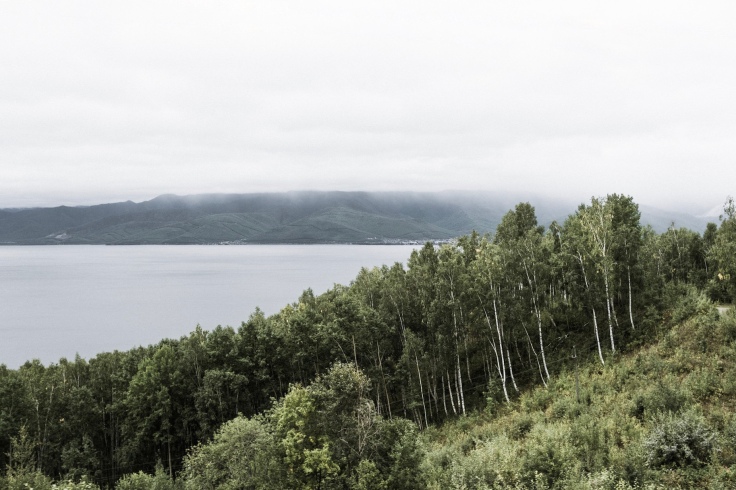
To keep our minds off the cold, we engaged in conversation with other passengers and Provodnica. That is how we met a Russian teacher, a very nice lady who was on her way to a new job – English lessons for elementary school pupils in the North Mongolia. We discovered that children in Mongolia learn Russian and English in elementary school and can already speak three languages as pupils. After a while, the heating was on and we could return to our daily activities on board: sleeping, drinking tea, eating (pretty much all the time), knitting and playing board games until we reached the border-crossing in the evening.

Border crossing procedure takes approximately 4 hours. During that time, toilets on the train are closed and get reopened only after the completed border crossing. This is also the case when approaching some bigger cities but you can always check with provodnica. Leaving the train is forbidden too so better take care of your needs before it. Firstly, the documents were checked on the Russian side, followed by a thorough check of the compartments/coupes by the Russian military officers. Prepare your passports, visas and migration cards on time. For people who need visa for Russia, it is important that you get your visa registered within the first week of your trip. You can either do it in the police station or at your hotel. Every medium-size hotel provides this service and will conduct the registration process for you. As a result, you get a paper confirmation of the registration. This confirmation has to be presented to the officials together with your passport. Petra, Nico and Alessandro managed to register their visas in Yekaterinburg. The same procedure followed on the Mongolian side in a more formal way but without thorough compartments check. That being finished, we finally went to bed, excited to wake up in Ulaanbaatar next morning.
Here are couple of information about Mongolia, once the most powerful empire in the world.
Country name: Mongolia
Capital (and the largest city): Ulaanbaatar
Official language: Mongolian
Official scripts: Mongolian Cyrillic
Mongolian script
Population (2016): 3,081,677
Currency: Tögrög (MNT)
Fun Facts:
- Mongolia is also known as a “Land of eternal blue sky”. It should not be surprising considering 250 sunny days per year.
- Ulaanbaatar is the worlds coldest capital city with average annual temperature of -1.3°C. Temperature in Ulaanbaatar can reach 33°C during the summer and down to -40°C in the winter.
- Mongolia is home to double-humped camels: Bactrian camels. They can be seen in Gobi Desert and near some nomadic establishments. These camels are very well adapted to withstand the extreme desert temperatures, with bodies made to store and preserve water for weeks. A very thirsty animal can drink 135 liters of water in c.a. 13 minutes.
- Mongolia is famous for its nomadic tradition and lifestyle. It is one of the last countries in the world to have such a high percentage of nomadic inhabitants (25-40%). It is also the most sparsely populated country in the world.
- Hospitality is a very important tradition in Mongolia. Guests are usually offered with the national drink called Airag, which is a fermented horse milk. Refusing the dink is considered very impolite. A guest is required to take a sip at least, if not drinking the whole glass.

I have to admit, Ulaanbaatar didn’t charm me at the first glance. Either because everything looked a bit greyish in the morning or because it looked to me like a huge industry zone divided between the coal power plants. Air pollution is a big problem in Mongolia. During the winter it almost never rains to wash the particles to the ground. That is why the air quality during the winter is beyond unhelthy standard given by WHO. In fact, the air is so bad that more and more children (but also the adults) experience breathing problems every year. Unfortunately, burning a raw coal is their principal source of energy and heating during the harsh winters. Switching to the processed coal (a bit cleaner form) is just too expensive for the country. Initiative for the air filters in the apartments is taking place now as an alternative solution. It is still in the process because the filters are also quite expensive and many people don’t have enough money to afford them.
For Mongolia, we booked a three-day tour to explore the national parks and nature. Our guide waited for us at the Ulaanbaatar main station with our driver ready and we headed immediately towards the nature. Here is what you can see in three days.
This article is purely based on my diary entries from that tour.
Ghorki-Terelj national park

Terelj is located east from Ulaanbaatar. It takes approximately 2 hours by car to reach it. Here I have to share one interesting fact about driving. Interestingly, the steering wheel of the vehicle we were in was on the right side, although people drive on the right side too (just like in Europe, apart from UK). The guide told us that Japanese cars are cheaper bought in their original state, with steering wheel on the right, and more people buy the cars like that. Therefore, you can imagine the difficulties of overtaking cars on the road from that position. One should have a copilot to navigate him and warn him, like our driver had our guide.

First thing we visited was The Aryabal Buddhist temple and meditation center. A path led us uphills teaching us many buddhist mantras along the way through small signs citing different mantras. Our guide explained us some basic principles and history of the buddhism in Mongolia as well as some religious customs. We learned that you should walk three circles around the temple, clockwise, before entering it, as a sign of respect. On the way to the temple, as well as around it, there were many prayer wheels. According to the lineage texts on prayer wheels, they are used to accumulate wisdom and merit (good karma) and to purify negativities (bad karma). We followed our guide in spinning them (clockwise too), just in case. This was the first buddhist temple that I entered in. One has to take off the shoes before entering that colourful wooden building. I’ve never seen so many colours and decorations in one place before. Everything is made of wood and, often, built without using any nails. Just by inflating and enmeshing the wood. Incredible carvings and decorations all around. I was really impressed.
Another interesting thing: an important number in buddhism is hundred eight. According to the teaching, this number is reached by multiplying the senses smell, touch, taste, hearing, sight, and consciousness by whether they are painful, pleasant or neutral, and then again by whether these are internally generated or externally occurring, and yet again by past, present and future, finally we get 108 feelings. 6 × 3 × 2 × 3 = 108.


After visiting the monastery, we descended to the starting point for a horse ride. Mongols are very related to animals, especially to horses, which they learn to ride already as children. Creating such a strong bound with an animal and training with it, it should not surprise the fact that their warriors were able to shoot with bow and arrow from galloping horses. Beautiful green mountains, tranquillity and sense of freedom were mixed in my head while leading the horse to follow the guide. If you decide to spend more than a day here, there are many ger camps to sleep in, hiking trails, beautiful field flowers and a giant Turtle Rock to see.
Chinggis Khaan Statue Complex

It is the highest equestrian statue in the world and it got acknowledged in the Guiness book of world records. Monument is made as a statue of Chinggis Khan on a horseback, looking symbolicaly towards east, where his birthplace was. Statue’s base is a museum in which two more items hold the world records. A nine-meter high leather boot, made exactly as the traditional Mongolian winter boots, just way bigger in size. The second item is replica of Chinggis Khaan’s whip. According to the legend, Khaan found his golden whip on that location. A very nice museum worker explained us about the museum, its construction and the two items. After that we explored the complex and learned more about Chinggis Khaan and his successors, as well as about the life of the nomads and evolution of the Ger, Mongolian tent. Climbing the top floor of the complex, you get on Chinggis Khaan’s horseback and can enjoy a panoramic view from above.
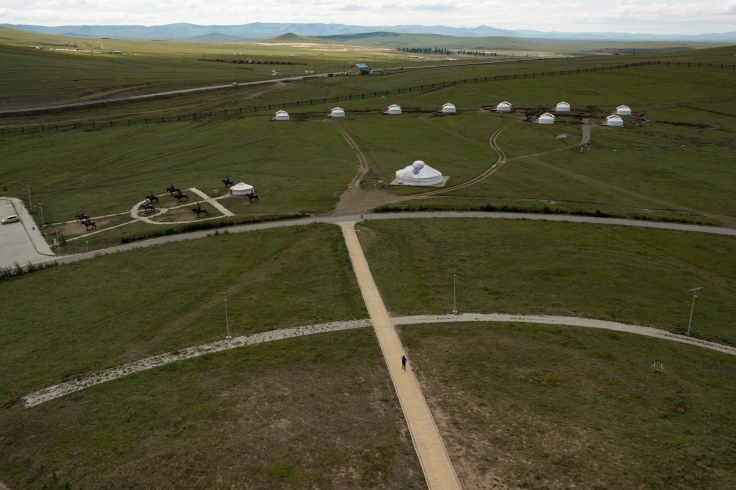
We had lunch within the complex and got a first chance to discover the typical Mongolian cousin, which is based on meat and diary products. So it was meat and more meat. Well prepared but too much for us who are not used to it. Or the vegetarians in the group 🙂 It is possible to get a vegetarian meal so don’t worry.
Khustai National Park
From the statue complex we proceeded towards Khustai National Park, hoping to see the Mongolian wild horses, also known as Takhi or Przewalski’s horse. They are endangered species, which almost got extinct. The last remaining heard inhabitates this national park. Meanwhile, we got to enjoy the ride and the landscape while getting to know better our guid, as well as Mongolian history and traditions. Endless steppe was stretching in front of our eyes, reminding me on sand dunes with a thin layer of grass.


We reached Khustai during the sunset. We were incredibly lucky that day because the horses were very close to the park’s entrance. This had the advantage of letting us see more of the horses but less of the national par, as we had to move on early the next day. This park was declared a Special Protected Area in 1993, one year after reintroduction of the project Takhi – preserving the last herd of the wild horses. It is located 100km west from Ulaanbaatar. It has an impressive biodiversity in both flora and fauna. It deserves spending a whole day or two for hiking, bird-watching as well as visiting the ancient ruins around it.
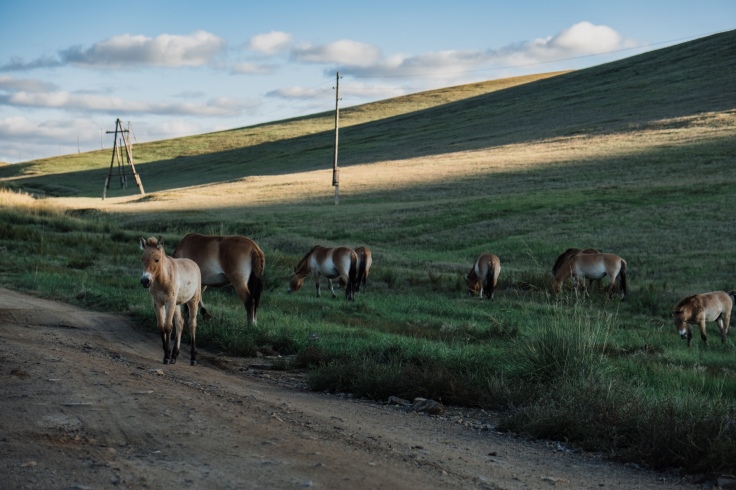
It was the first night to spend in a ger. Ger is a portable round tent. Its structure consists of angled lattice assembly of wood and/or bamboo. It is usually covered with skins or felt. A family can put a ger up in approximately 60 minutes. Campsite gers are usually equipped with several beds and a wooden oven in the middle for heating.
There are three options of overnight stay in ger:
- Visitors camp: Campsite with xapprox. <30 tents, equipped with electricity from the main building of the camp, common toilets and a shower block. Main building has also a big restaurant offering both breakfast and warm meals.
- Guesthouse ger: a larger ger campsite with approx. >30 tents. Electricity from the main building is provided for having the light in the tent. It usually has the main building with a small restaurant and an external common toilet. Showers are not necessarily present.
- Family ger: Ger rented from a nomad family. It is also the most adventurous experience if you are ready to accept almost none of the toilet facilities. On the other hand, you get to know local people, share bread with them and learn more about their lives. Family usually stays in their ger and they rent you a separate one nearby. Meals are usually prepared and eaten together with the family.
After the dinner, while we were watching the documentary about Khustai national park from the 1990s, a staff member from the ger camp came and lit up the fire in our gers. We played a bit of Wizar, drunk thr remaining vodka and went to sleep. Maintaining the fire was not top priority and it (naturally) went off during the night. It became incredibly cold. Already at the beginning of September, the temperature during the night is -5 degrees.
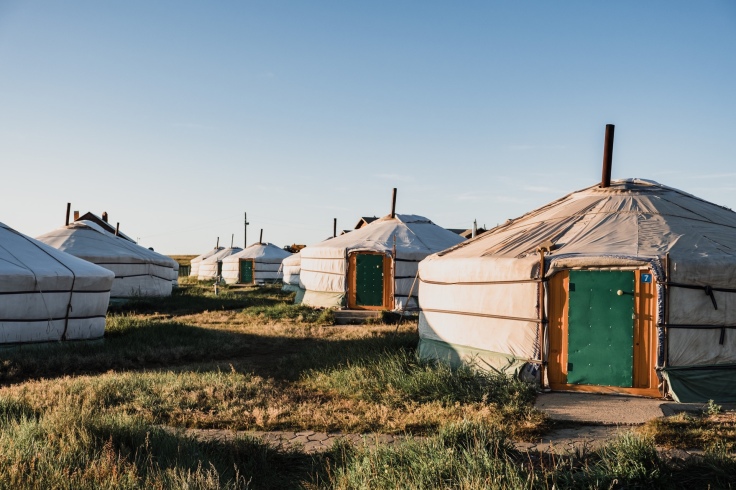
I think I reached my maximum in getting tight in foetus position (my sleeping position) until the morning. Morning stretch of the legs or arms was not an option, every millimeter around me was ice cold. However, as soon as I got out and felt the morning sunrays on my skin and saw the landscape in front me, all the cold was suddenly gone. But the hunger wasn’t. So we went to the main building of the camp for a breakfast and a cup of good black tea. The guide and the driver were already there. They didn’t forget the fire.
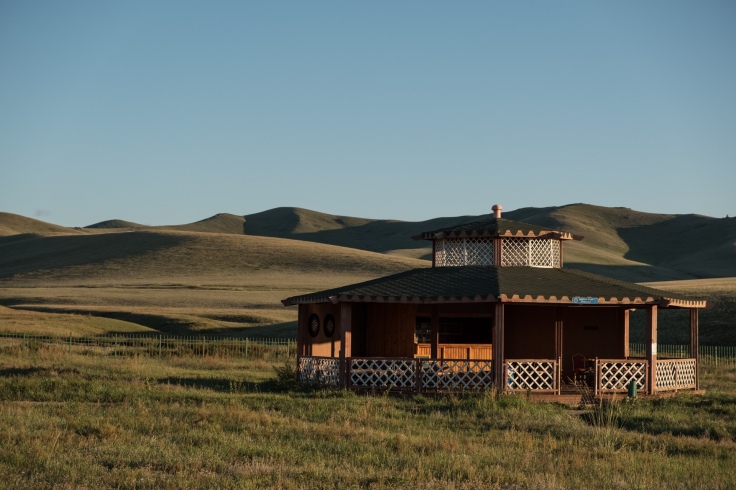
Kharkhorum
We started our very long ride to Kharkhorum, Chinggis Khan’s home town and previous capital of Mongolia. We stopped on the way to take some breathtaking photos of the landscapes. This country is a photo paradise and it is always sunny.


First stop we made was to visit a Mongolian family and two-hump-camel ride. The idea was to have lunch with them in their ger but mother was absent because of something she had to finish at the time. We anyway met the father and the older son who helped us climb the camels.
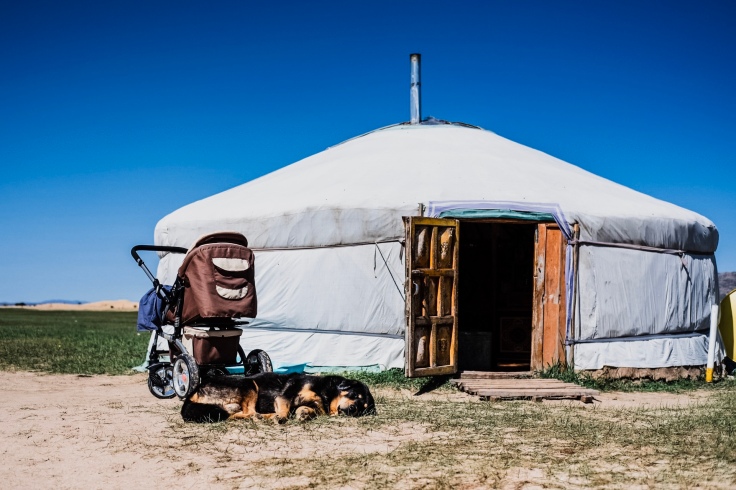

At this very place, there was a 80km long sand desert. Even the deserts can be nomadic, just like this one that moves every year as the wind blows and changes its position. We were a 5-camel-long caravan (including our guide) guided carefully over the sand by a boy, who was already experienced guide of this type. We rode back to the ger where we gave presents to the family members and shared a homemade bread-butter dish with them. We were offered tobacco as well. This was a whole new experience since they didn’t smoke the tobacco but sniffed it. Before I could say anything, a large piece was rubbed into my nose by the head of the family. For a second I thought my nostrils were going to explode, then it slowly got better.

The ride continued and in the late afternoon we were in Kharkhorum, or at least at what remained after the Chinese march through Mongolia. We visited two historical museums at the site and learned some interesting facts, e.g. that Turks originate from Mongols. We also read a very interesting and witty transcription between Roman Pope and Khaan. We could also get the idea from the city miniature how it looked once. Coloured by the last sun rays in what looked like a golden desert, Kharkhorum remains outside of the museum looked beautiful.

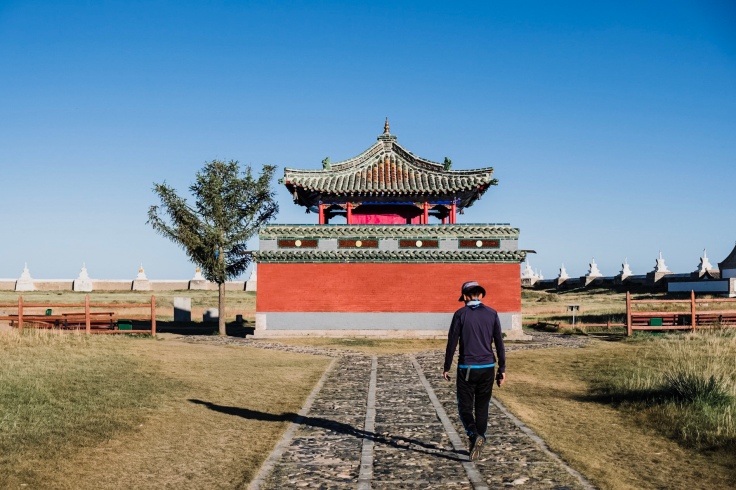

This second night we were about to spend in a guesthouse ger. Considering the experience from the night before, the decision was made that all four of us sleep in one ger so that fire can be maintained easily and that we feel warmer. After the dinner, the fire has been lit up in the ger so much that it felt like a sauna. When it cooled down a bit with opened door we started our Wizard battle after which we went out for some night photo shooting. Despite the cold and a bit of the light pollution from the camp, we enjoyed the starry night above the steppe.
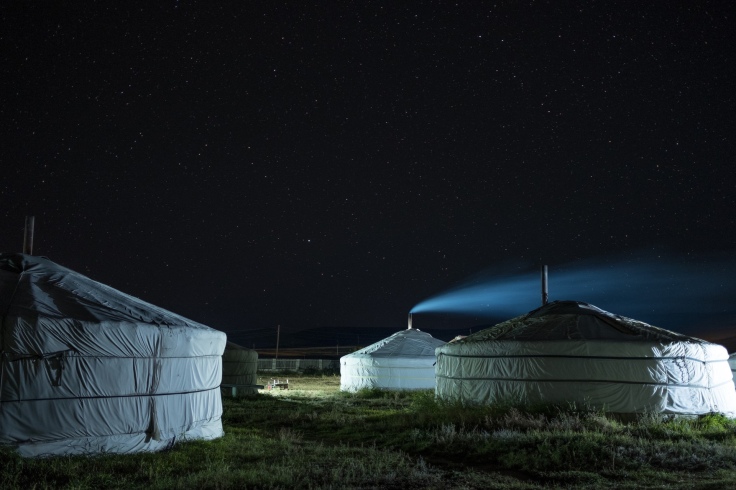
The long ride to Ulaanbaatar was the plan of the following day. We started early in order to arrive during the daylight. First stop was a nice lake in the middle of the steppe. Quite big and blue in that desert-like landscape.

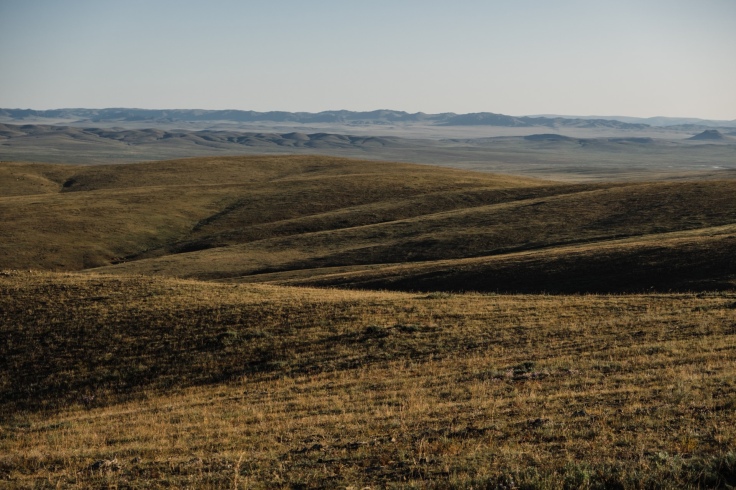
Not far away from the lake, taking an almost invisible country road, we arrived to a small museum next to the ruins of the noble man’s palace and a small pagan worship fortification. It was so sad to see this small museum, falling apart slowly because it is not well maintained. The priorities in the country are the other things and not these almost forgotten places deep in the steppe. I hope they will invest something into renewal before the historic artefacts get completely damaged.


During the long ride we enjoyed the wild steppe landscape once again, feeling overwhelmed with the beauties we took in in the last days. Mongolia should be on everyone’s wishlist. It has to offer magnificent intact nature that is always under the sun’s watchful eye, friendly people and a lot of history. It connects one back with his roots, with the nature and it’s beauties. We came to Ulaanbaatar in the afternoon and went to an observation platform above the city. Such a contrast between these modern buildings and skyscrapers, surrounded by enormous coal plants and intact nature all around. The city didn’t charm me again, and how could it possibly compared to nature just couple of steps away from it.

You can organize different tours in Mongolia and adapt them to your time and preferences. If you like history, you should definitely visit ruins of Kharkhorum and learn more from the first hand about the development of the empire, the Khaan dynasty etc. If you are more of a nature lover, spend an additional day in national parks and go hiking. If I wasn’t so charmed with Ulaanbaatar, maybe you will be and I would love to hear about it. If you plan a separate trip to Mongolia, not as a part of the Trans-Mongolian railway, you should check the event calendar and visit the eagle festival in the north-west, or go further south to the Gobi desert for a different experience. In any case, go into nature and enjoy the unusual tranquillity of the intact nature and silence of the steppe. A privilege we don’t have in big cities.
We boarded next morning on a train to Beijing, still under the spell of the previous three days.
To be continued.

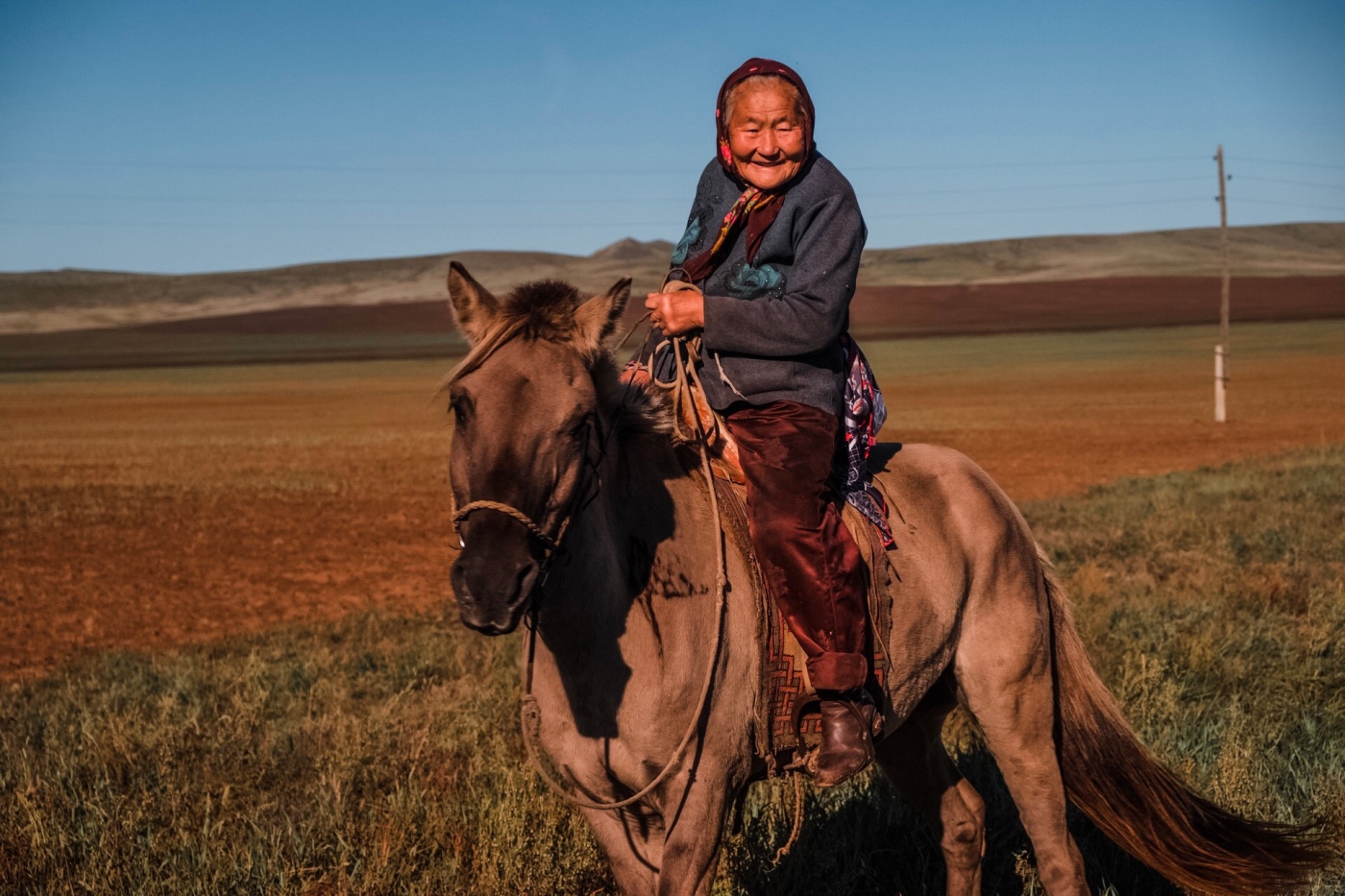
Nice article and beautiful images Milica, Some additional information regarding the Trans-Siberian route is available on this blog: https://www.monkeyshrine.com/news/
Enjoy the reading,
Guy
LikeLike
Hello Guy,
thank you very much for your feedback 🙂
I like your articles too. It is always interesting to read about the same places but from a different perspective.
Keep it up 🙂
Greetings,
Milica
LikeLike